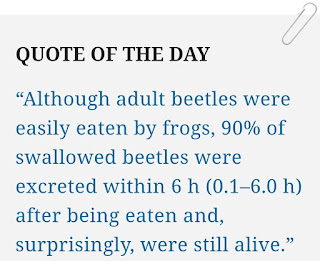I do that sometimes; I file them under 'Blog fodder' in my phone, as useful little prompts for future updates.
One day I'll get to write about my little note that reads: 'Is nature amoral?', but for now let's consider 'why bother' shall we. Here's a photograph of what I found that prompted me to write this particular note...
A beautiful wasp. Yes it is a Chalcid wasp, possibly something like a female 'Ormyrus nitidulus'. Ormyrids are often recorded in association with plant galls, but are not gall-formers themselves: rather, they are parasites of the insect larvae that formed the galls. Probably because of their minute size, they are under-recorded and so their true status is hard to determine objectively.
And the question I was asking myself was...
But the real question is, why does nature bother?
Yes, why does nature bother with creating such a vividly coloured creature when it is so very small and barely visible at all?
Dunno! But I'll come back to it after I have had a think because I do have a bit of a theory, deary!
Take a look at this chart for Aglais io - the Peacock Butterfly...
It has the larvae period as mid May to early July and pupae as 2nd week of June to 1st week of August. Yet here we are at the very end of August and I have discovered some larvae on nettle. Intrigued to see what happens, I am monitering them and at least three have now become pupae. They are quite stunning at this stage...
You can see the remains of the shed 'skin' just to the left of the pupa. So what is going on with this really late sighting? Well this butterfly is generally single-brooded, but in good years, with the right weather conditions, a small second brood may appear. These do over-winter as adults and so should just about have time to take on some fuel before hiding away for the winter.
This is what the adult butterfly looks like...
The other note I mentioned at the top of this update was 'Don't always believe what you are seeing'. Here's the photograph that prompted me to record that one...
I've deliberately displayed this small to better represent how it looked to me at first sight. It was actually not as clear as this photo because the light was poor at the time, it had actually been raining.
Anyhow, I just thought something along the lines of 'Hmmm, there's maybe a tiny hoverfly egg or something there'. When I took a closer look through the lens I could see exactly what it was and so I carefully moved it onto a leaf for a better photo...
Or perhaps there were two (or even three) all along, but I just didn't spot the other one, because I think where I have circled in this photo might be an exit hole?
And so here's the grizzly truth: these are wasp parasites that have invaded the caterpillar. The tiny larva lurks inside the flesh of the caterpillar, soaking up its host's nutrients and drinking its blood. The wasp larva must keep its host alive, so it avoids damaging the vital organs. The caterpillar swells as it eats, not knowing what lies ahead.
When the larva is ready to break out, it releases chemicals that paralyse the caterpillar. With its host stuck, the larva uses specialised, saw-like teeth to eat its way through the thick skin.
Remarkably, the wounded caterpillar does not always die. Some species even watch over the newly free larvae until they spin their own cocoons, ready to become adult wasps.
Information courtesy of The Natural History Museum.
It barely resembles a moth does it, as it settles head-down with wings wrapped tightly around its body, on a grass stem.
Other creatures are disguised by Mother Nature to resemble something much more fearsome than they actually are by the use of false eye spots: like this Emperor moth...
Still more add in nasty tasting hairs as well as bright warning colours, witness this Sycamore caterpillar...
But is that the reason nature bothers to give the tiny wasp such garish colours?
BBC SCIENCE tackled the question of why some insects have vivid, metallic green, blue or gold colouration. It discovered that this effect doesn’t come from pigments, but is an example of ‘structural colouration’.
Microscopic ridges and transparent layers on the surface of a bug's body act as an array of lenses that direct different wavelengths of light in such a way that some colours cancel out and others are amplified – the rainbow effect on a DVD is similarly caused by pits on its surface.
This metallic sheen may have evolved because it offers bright colours that can serve as a mating signal over long distances. Alternatively, some researchers have suggested that it might mimic the appearance of raindrops on leaves, helping to camouflage the insect.
Perhaps my hunch about camouflage wasn't too far off after all? The truth is probably akin to what Agatha Christie once said about what other people are thinking...'nobody knows'.
By the way chums; if you are thinking this update has been bereft of the usual smattering of humour, I can only apologise. I think what happened was that I went to bed one night and when I woke in the morning, I'd somehow undergone a funnybone excision. Fear not though, I am hopeful of getting the surgery reversed, it's just that you know how the NHS waiting times are at present.
How about some bonking beetles, just to exercise your giggle stick a tad?
I think those are 'Rhagonycha fulva' but as they are only here for comedic effect, I won't be too discombobulated if they are not.
Time I was on my bike I think; now where did I leave it? Oh yes, it's in the garage with a flat tyre isn't it. Oh well, there's always the ever trusty shanks's pony!





























































